Being an alpine photographer can be uncomfortable, even dangerous. An alpine photographer should never expect nor anticipate sunny skies, as they may be engulfed with snow storm clouds within moments. The air is cold and thin with the threat of avalanches lurking around every turn, and the bitter mountain gales threaten to upend a climber’s near-vertical position with potentially fatal consequences.
Nothing of the sort has been enough to keep Jackson Hole-based alpine and snow sport photographer Chris Figenshau off of the nearest peak. A journalism school graduate turned adventurer, Figenshau chooses to photograph the globe’s highest altitudes out of a joy in sharing his surroundings with others.
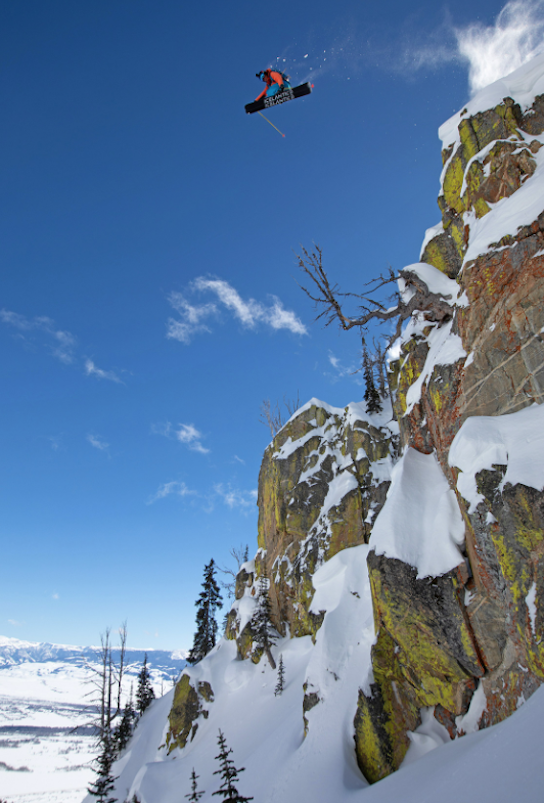
Owen Leeper dropping a huge cliff in the Teton Backcountry, Wyoming. Photo by Chris Figenshau.
The first clicks of his shutter
Figenshau grew up in East Lansing, Michigan, before heading west to the University of Oregon at Eugene to study magazine journalism. At the time, he was set on being a writer, but always had a film camera at his side as a photography hobbyist. He worked part-time in a darkroom while in school but by no means was a professional yet; after all, he was going to be a writer.
“When I was in college, I didn’t really know what I wanted to do, because who does at 23?” Figenshau told Kinute. “You pick a skill but that changes with your interests. That’s kind of how I ended up in journalism, and how I ended up in photography as well. I developed some skills that I could take along with me and if I change my mind or want to do something different, I could use those same things. I’ll tell you later if that’s paid off.”
Skiing was Figenshau’s first love. Figenshau did not yet realize that a winter ski trip to Jackson Hole shortly after graduating would change the trajectory of his career forever. While taking some for-fun pictures in the powder, something new and important clicked for him—his first shutter clicks as a ski and alpine photographer, that is. Figenshau’s camera quickly became a permanent extension of his arm and the writer’s pen fell to the wayside.
That was nearly 30 years ago. Figenshau has lived in the Wyoming resort city ever since, taking the Jackson Hole Mountain Resort photo of the day—an ongoing project that is “an excuse to get out and ski every day,” Figenshau laughed—and following climbers up into the mountains.
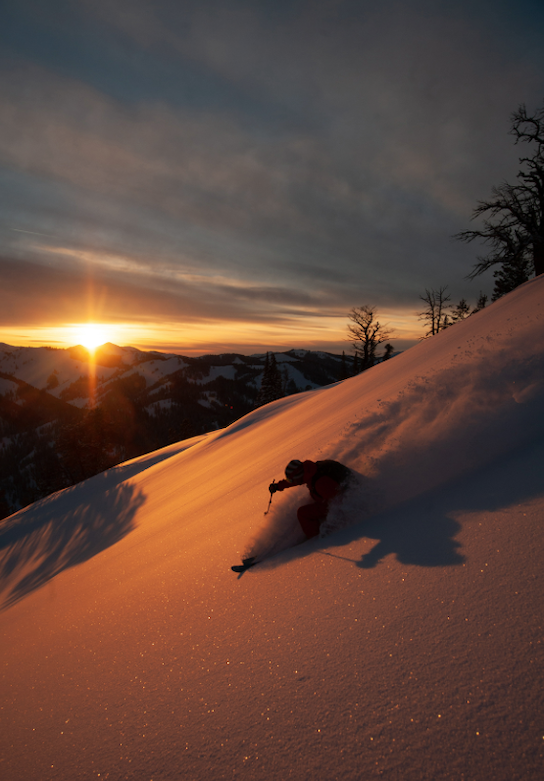
Shroder Baker at last light on Teton Pass, Wyoming. Photo by Chris Figenshau.
About halfway into his photography career, cameras began to change. At newspapers and magazines, darkrooms became cluttered with boxes of old issues, Christmas decorations and extra office chairs. Digital enhancement of photos ramped up with the introduction of advanced post-production editing software. Camera film became more of a novelty than a necessity in stores.
Figenshau was among the generation of photographers who learned an entirely new camera language and system to keep his work modern.
“I have file cabinets full of slides in my garage, but I had hard drives full of digital shots as well,” he laughed.
While Figenshau feels he is mostly self-taught, he’s had the opportunity to work with some very influential and talented people, including Jimmy Chin, Conrad Anker and Renan Ozturk on the 2015 documentary "Meru," which detailed the group’s 2011 successful attempt to summit India’s legendary Meru Peak through the Shark’s Fin trail.
Figenshau worked in filmography for that project, and was introduced to his interest in motion pictures as well as photography. He also scaled India’s Papsura, known as the Peak of Evil, with renowned ski mountaineer Hilaree Nelson twice. Later in his career, he added more film projects to his portfolio with production companies like Teton Gravity Research and Warren Miller.
While he didn’t have any one person take him under their wing to teach him everything there is to know about the industry, Figenshau was highly observant of the experts around him; his observations acted as his mentors.
“There weren’t that many people doing [alpine photography] at the time. It was a very small thing,” he recalled. “The highlight of your career was an advertisement in Powder Magazine. Since then it’s a totally different field. Outdoor photography is more common, there’s more of it. The internet makes it more competitive.”
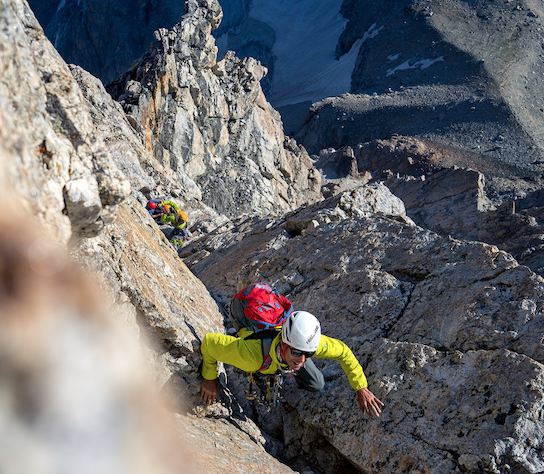
Kent McBride guiding the Grand Teton's Exum Ridge. Grand Teton National Park, Wyoming. Photo by Chris Figenshau.
Inspiration at 10,000 feet
Figenshau’s photography journey began with ski photography, capturing gear-clad skiers as they ripped through perfectly white snow. His action shots of the cold-weather athletes have been featured with brands including The North Face and Eddie Bauer.
“That was the thing I wanted to do the most, and what brought me into photography in general. I just was so immersed in mountain skiing and wanted to document the things that we were doing because I thought they were so cool,” Figenshau explained. “But I think, over time, if you do something long enough you start to find new interests.”
Now the photographer pursues a stronger storytelling component to his work. Capturing something that’s iconic and telling a larger story in the realm of action sports is a challenge, but Figenshau dug into how he can show the culture and people behind the sport rather than just sprays of snow and death-defying ski stunts.
“The hardest thing to do is capture something that will stand the test of time and tell us a story about the moment that was captured,” Figenshau said. “That’s something you can look at years from now and it’s still powerful.”
When asked whether the best shots are staged or just happen, Figenshau said that, in his field, it’s a little bit of both. Ski photoshoots for a brand catalog, for example, often are required to have perfect snow conditions, sunny skies and the brand icons strategically visible. Those shots happen in highly coordinated environments.
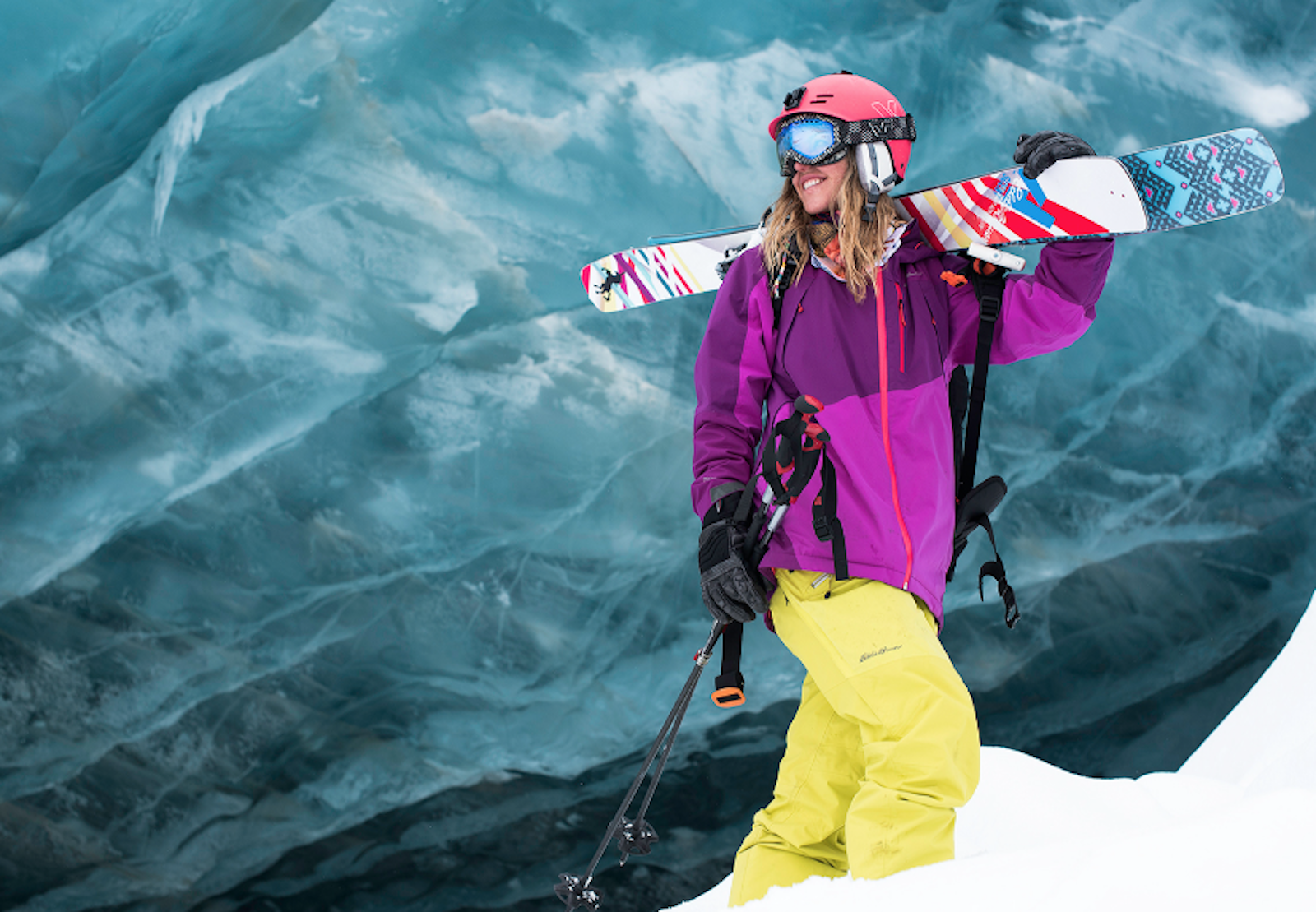
Lynsey Dyer in the Monashee Mountains, British Columbia. Photo by Chris Figenshau.
“But I think a lot of the best shots are sort of anticipated,” he said. “Being able to switch out of producing something and just reacting to what is happening is important.”
With his hands are thickly layered in cold-weather gloves for his high-altitude shoots, the dexterity required for a camera's small, intricate dials and buttons can be lost. Despite that, Figenshau joked, he's able to get something if he mashes the shutter button enough.
Alpine photography was an extension of what Figenshau loved to do, give or take a few thousand feet in altitude. He sees himself as a documentarian, bringing the experience at remote mountain peaks back to people who can’t get there themselves. Photographers, he said, get to tag along to activities they may not otherwise experience, like mountain climbing—assuming, of course, the photographer is in good enough physical shape to scale a mountain themselves.
“It was kind of selfish, but I thought ‘this is how I’m going to see a bunch of cool stuff and to be the person that documents it,'” Figenshau explained. “You have to love what it is that you’re documenting. You also have to be able to keep up if you’re doing, for example, a ski mountaineering objective. You have to be fit enough, technically savvy, as well as the camera man. It involves a large skill set.”
Dark side of the mountain: Risks and challenges
What Figenshau does brings people to mental and physical breaking points. The environments he works in are often risky and dangerous, requiring extreme physical exertion. The pain, exhaustion, and risk of it all just enhance the final view at the summit’s end.
“It’s challenging and it’s rewarding,” Figenshau said. “It’s just beautiful. Even if you’re not a mountaineer, I think you can appreciate the beauty of being in mountains, especially if it’s a really special moment when the light is good, the snow is good. It has a special sort of sanctity that I think anyone can appreciate.”
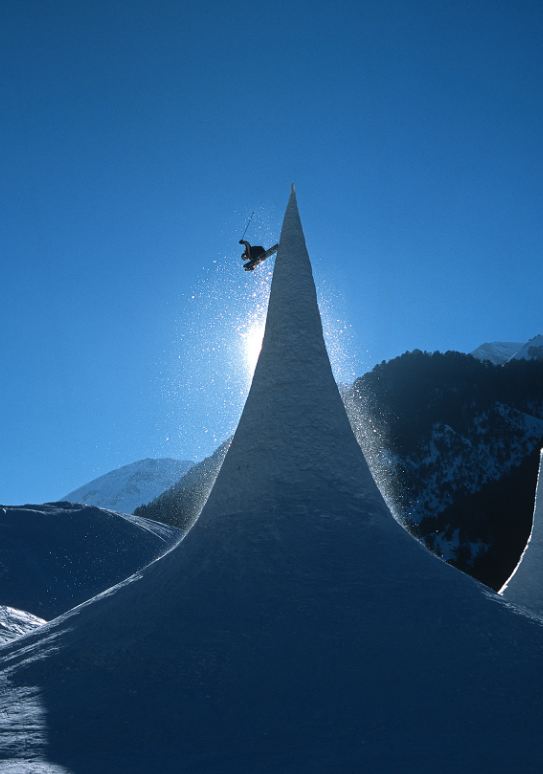
Marc- Andre Belliveau transitions to down along a sculpted snow spike in Bansko, Bulgaria. Photo by Chris Figenshau.
How far should a human go—how much should a person be willing to lose—to lay their own eyes on one of the most powerful, breath-snatching views the planet offers? Before a mountaineer can appreciate a peak, or watch the sunset sink over a snow-shrouded valley, they must first get there alive. The beautiful scenes at the top, the photographer said, are just as impactful as the most perilous experiences on the summit. In his decades of work, Figenshau has seen people fall, get injured, get crushed under avalanches—sometimes fatally.
“We’ve lost so many friends over the years to ski accidents,” he recalled. “I think if you’re doing backcountry skiing for a number of years, your list of people that have passed doing it gets bigger as you grow older. It’s kind of a harsh reality for the sport and the variables that go along with it.”
Just like with any other pursuit, mountaineering should be a balance between taking risks and playing it safe, because “it’s real, it’s scary, it can hurt you and it can kill you,” Figenshau said. He offered the analogy of an astronaut: limited food and clothing, a tight timeline to pull off an objective, cold temperatures and unstable environments, and only so much one can do with what they’re carrying on their back.
“I think you get older and you look back and think maybe you just survived, luckily,” Figenshau said. “And as you get older, you become a little bit more calculated in things that you take on, so I'm in the ‘getting more calculated in the risks I take on’ category at this point.”
The risk can depend on the height of the climb. The Himalayas, the peaks of which scrape the sky at up to 25,000 feet, can be more affronting than the Tetons or the Wind River Range.
“It’s hard not to be impressed by just how massive the Himalayan mountains are,” Figenshau said, “but it’s also hard not to be content with the friendliness of some of the mountains around here. The Wind River Range in its own way is super impressive, with just how wild it is and how close it is to where we live.”
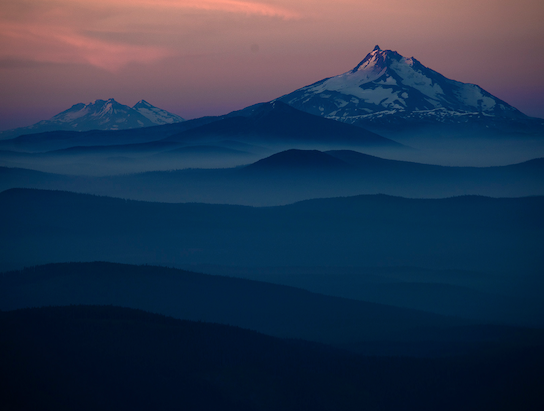
Mt. Jefferson, Oregon, shrouded in smoke. Photo by Chris Figenshau.
Figenshau has luckily made it this far without critical injury. He’s dug people out of avalanches and witnessed bad accidents, and it all has made him aware of how quickly things can go south. In climbing the Peak of Evil, for example, there were sunny skies and good visibility going up, but clouds rolled in and a fog bank destroyed visibility in a second. The whole descent, Figenshau said, was “just surviving” as the group blindly made its way down the mountain. The climbers also battled altitude sickness and food and water contamination, showing just how difficult it is to accomplish an ascent of that magnitude.
“When you see pictures from high altitude peaks of people skiing on what looks to be good snow and with good light, for all intents and purposes, it's a great shot,” Figenshau said. “If the altitude of the peak in that shot is above 6,000 meters, that's a real special moment that you're looking at, because they don't happen that way all the time. I'd say mostly not, mostly it’s not that good up there.
“When I see a picture from certain places, I realize how much effort and luck might have gone into that.”
As if being thousands of feet above ground level in environmental conditions not meant for human beings weren’t enough, the threat of wildlife encounters is sometimes at play. In his trips to the Arctic National Wildlife Refuge, Figenshau and the group he was with carried guns as they trekked out into highly remote places teeming with predators, carefully stepping over the tracks of bears, wolves and wolverines.
“That’s a place where there’s a very robust ecosystem for animals and bears. It’s one of the only places that has brown bears and polar bears intermingling in the same dining grounds,” Figenshau said. “So it’s a really unique and special place to visit.”
In a different time, nothing of the sort—avalanches, bears and falling hazards—has been enough to keep the Jackson Hole-based alpine and snow sport photographer off of the nearest peak. Times, however, have changed, and now two very good reasons hold Figenshau’s hand and look up to him with wide eyes.
“It’s true what they say, that having kids will change your perspective on what kinds of risks are acceptable,” he said. “They’re always part of my decision-making process. The one great thing about being a photographer or a writer is that you can apply that skill to anything, so if your interests change or risk tolerance changes, you can accommodate that by pursuing other subjects or pursuing the same subject in a different way.”
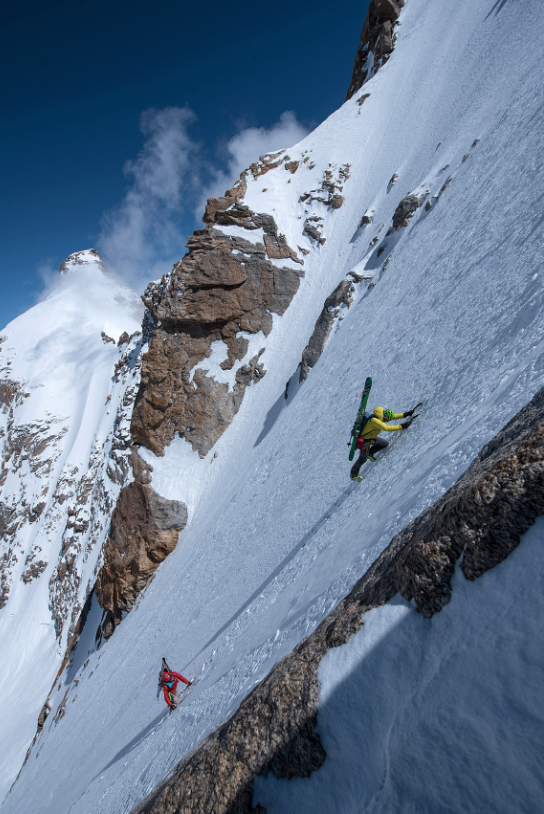
Jim Morrison and Hilaree Nelson ascending Papsura, Himichal Pradesh, India. Photo by Chris Figenshau.
A great view: Looking forward
“In 10 years? Well, in 10 years, I’ll be 60 years old,” Figenshau said of his future plans. “I see [my work] changing, trying to make accommodations for being a dad. Hopefully in 10 years I'm doing a lot of these activities with them.”
Figenshau’s sons are 5 and 8 years old. They already enjoy being out in the snow with their dad, and he hopes their love of the outdoors prevails.
“I want that to be a big part of their character and childhood,” he said. “They don’t know how lucky they are to have all of this around them. I imagine someday they’ll appreciate it.”
If he could go anywhere, Figenshau would take a trip to Scandinavia, Norway specifically. With a Norwegian last name, Figenshau would like to trace his genealogical tree back to its origin and take his kids to where his family originated.
“Time will tell if [my kids] are intrepid adventurers or not,” Figenshau said, and laughed when Jimi, his 5-year-old, declared “no” in the background. The dad hopes to take his family into the Wind River Range, India and Nepal someday, showing them the sights he’s seen without the added risk.
The photographer enjoys flyfishing when he’s not halfway up a mountain. The river acts as a calming counteract to the exertion mountain climbing puts on the body.

Robert Meiswinkel presents and elusive bonefish in the southern salt flats of Matanzas, Cuba. Photo by Chris Figenshau.
“It gives me a nice little break,” he said. “After being in the mountains, being in the river is sort of my antithesis to that.”
